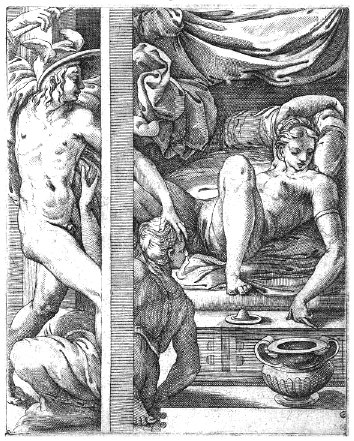/
EN
| Gian Giacomo Caraglio Merkur and Herse 1527 Hamburger Kunsthalle, Hamburg, Germany |
|
Rights (Photo / Work):
CC0 // Wikipedia List of sources: |
The graphic reproduction is one of the sets from "Love of the Gods" which was painted by Rosso Fiorentino and Perino del Varga and copied and engraved by Caraglio[1]. This erotic set was one of the most popular of this age. By means of the copper engraving it was easy to reproduce the painting. It was thus not only available for the important bourgeoisie or nobility. "Merkur and Herse" shows three people who are embedded in a mythological context and thus represented as deities[2]. The woman lying on the bed exposes her sexual organ. The artist represented her genital in the form of a depilated vulva and shaped the inner labia. Due to the protagonists' camouflage as deities, the copper engraving wasn't perceived as scandalous at the time. Provocative Renaissance pictures are at the beginning of a tradition which reduces eroticism and desire to images of women in lascivious poses. In comparable pictures from the Middle Ages, for example bathing scenes, in which women were always shown naked or half naked in an erotic context men were depicted in the same way. This made up for an erotic counterbalance[3].
Biography: http://de.wikipedia.org/wiki/Gian_Giacomo_Caraglio (Translation: C. Wilhelm) |


